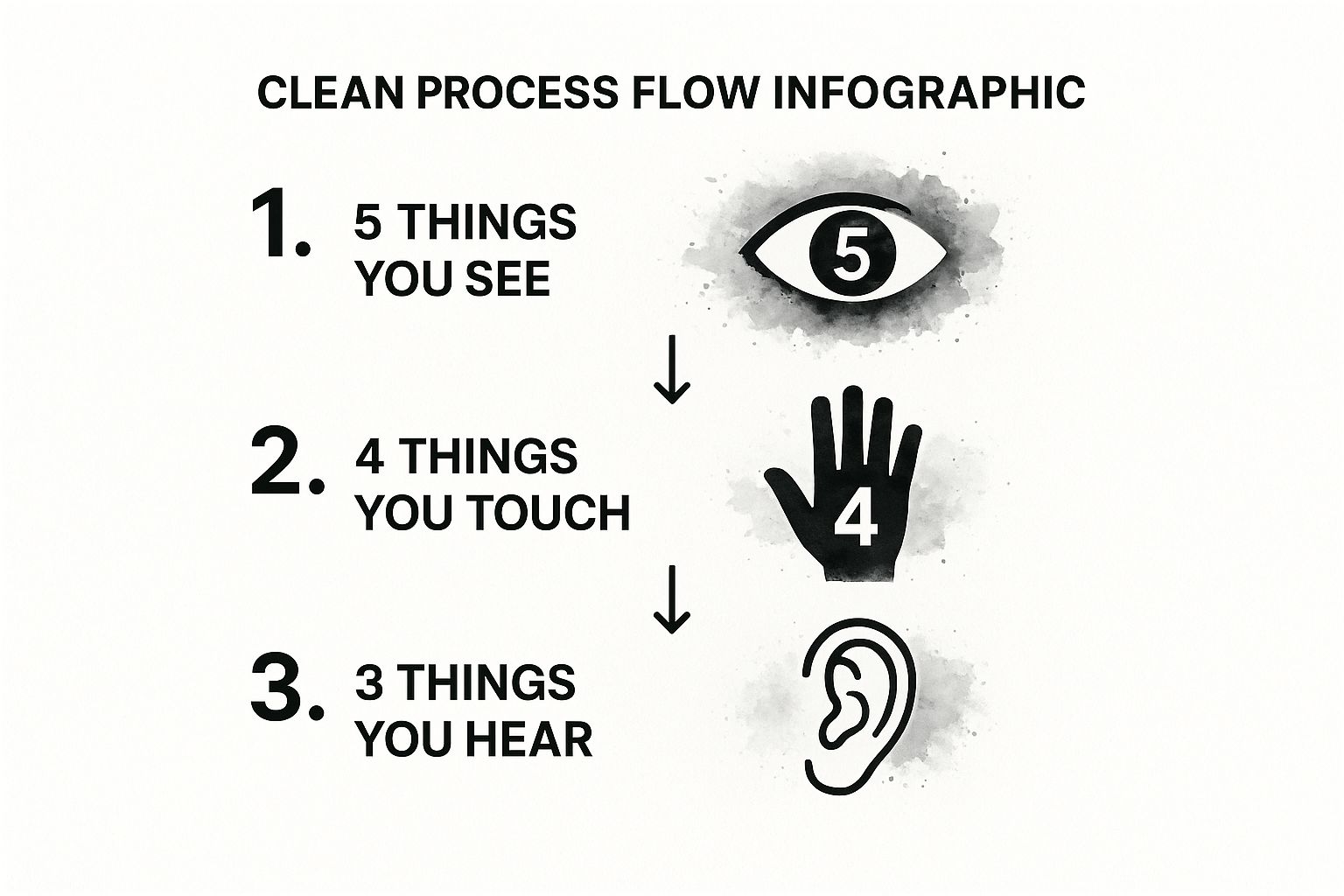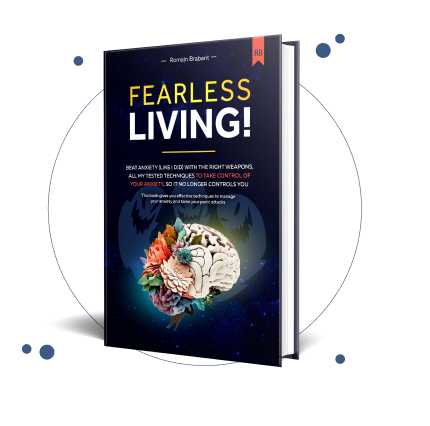
Panic attacks can feel like a tidal wave, overwhelming you with intense fear and physical symptoms that make you feel powerless. It’s a terrifying experience that can leave you living in dread of the next one. But what if that feeling of powerlessness could be transformed into a sense of control? What if you had a toolkit of proven methods to not only survive a panic attack but to significantly reduce its power over you? This article isn’t just a list; it's a message of hope and a practical roadmap. Healing from anxiety and living a life free from the grip of panic is not just possible—it's achievable.
We will explore powerful, evidence-based coping strategies for panic attacks that can anchor you in the present, calm your nervous system, and help you reclaim your life. Each technique is a step toward building resilience and proving to yourself that you are stronger than your anxiety. Beyond these specific techniques, understanding foundational skills is also key. Exploring resources on emotional regulation activities can significantly enhance one's overall ability to manage the intense feelings associated with panic. Your journey toward fearless living starts now.
1. Deep Breathing Techniques
When a panic attack strikes, your body’s fight-or-flight response takes over, often leading to rapid, shallow breathing (hyperventilation). This can intensify feelings of panic, dizziness, and terror. Deep breathing is a powerful, foundational coping strategy for panic attacks because it directly counteracts this physiological response. By intentionally slowing your breath, you activate the parasympathetic nervous system, which acts as your body's "rest and digest" command center, calming the storm of anxiety.

This technique is not just about taking deeper breaths; it’s about controlling the rhythm and depth to signal safety to your brain. Mastering this skill gives you a reliable tool you can use anywhere, anytime, providing a sense of control and hope that you can manage these intense moments and move towards a life free from panic.
How to Practice Diaphragmatic Breathing
Diaphragmatic, or "belly," breathing is one of the most effective methods. Unlike shallow chest breathing, it engages the diaphragm, a large muscle at the base of the lungs, for a fuller, more calming breath.
- Get Comfortable: Sit or lie down in a comfortable position.
- Hand Placement: Place one hand on your upper chest and the other on your belly, just below your rib cage.
- Inhale Slowly: Breathe in slowly through your nose for a count of four. As you inhale, focus on allowing your belly to rise and push your hand out. The hand on your chest should remain relatively still. This ensures you are breathing deeply into your diaphragm.
- Hold Briefly: Hold your breath for a moment or two.
- Exhale Slowly: Breathe out slowly through your mouth for a count of six. Feel your belly fall as you gently release the air. Making the exhale longer than the inhale is crucial for activating the relaxation response.
Key Insight: The goal is to make your breathing smooth, deep, and controlled. It may feel unnatural at first, but with practice, it becomes a second-nature response to rising anxiety, offering a pathway back to calm. For more structured exercises, you can find a variety of helpful breathing techniques for anxiety on anxietychecklist.com.
2. 5-4-3-2-1 Grounding Technique
During a panic attack, your mind can get caught in a terrifying loop of catastrophic thoughts, making you feel detached from reality. The 5-4-3-2-1 grounding technique is one of the most effective coping strategies for panic attacks because it pulls your focus away from internal fear and anchors you firmly in the present moment. By systematically engaging your five senses, you interrupt the panic cycle and redirect your brain's attention to the tangible world around you.
This powerful sensory exercise helps you regain a sense of control by proving that you are safe in your current environment, not in the imagined danger your mind is creating. It's a structured, easy-to-remember tool taught in cognitive behavioral therapy (CBT) and used in emergency settings to quickly de-escalate acute distress. Mastering this technique offers profound hope, demonstrating that you can actively steer yourself out of panic and back to a state of calm.
The following infographic illustrates the initial, most crucial steps of this process flow, helping you visualize how to begin re-engaging your senses.

This visual guide highlights the sequence of observing, feeling, and listening, which forms the core of the grounding exercise and initiates the shift from internal panic to external awareness.
How to Practice the 5-4-3-2-1 Method
When you feel panic rising, start this sequence. If possible, say each item aloud to further engage your brain and solidify your connection to the present.
- Acknowledge 5 things you can see. Look around and slowly name five distinct objects. Notice details: the color of a book, the texture of a wall, the light from a lamp.
- Acknowledge 4 things you can touch. Focus on the physical sensation of four things. This could be the feeling of your feet on the floor, the texture of your jeans, the coolness of a glass, or the softness of a blanket.
- Acknowledge 3 things you can hear. Listen carefully and identify three sounds. It could be a clock ticking, a car passing by, or the hum of a refrigerator.
- Acknowledge 2 things you can smell. Try to pick out two distinct scents. Maybe it's the smell of coffee, soap on your hands, or the fresh air from an open window.
- Acknowledge 1 thing you can taste. Focus on one thing you can taste. You can take a sip of water, chew a piece of gum, or simply notice the current taste inside your mouth.
Key Insight: The power of this technique is its simplicity and structure. It doesn't require any special equipment and can be done anywhere. By practicing it during calm moments, you build the mental muscle to use it effectively when panic strikes, giving you a reliable path back to safety and proving you can live a life free from panic. For a deeper dive into this and similar methods, explore these additional grounding techniques for anxiety on anxietychecklist.com.
3. Progressive Muscle Relaxation (PMR)
Panic attacks flood your body with adrenaline, causing muscles to tense up involuntarily. This physical rigidity sends a powerful signal back to your brain, reinforcing the sense of danger and amplifying the panic cycle. Progressive Muscle Relaxation (PMR) is a specific coping strategy for panic attacks that directly addresses this physical tension. By systematically tensing and then releasing different muscle groups, you learn to consciously recognize and let go of stress held in your body.
This technique, originally developed by Dr. Edmund Jacobson, works by creating a stark contrast between tension and relaxation. When you intentionally release a tensed muscle, the resulting state of deep relaxation is more profound than it would be otherwise. This physical release calms your nervous system and shows you that you have direct control over your body's stress response.
Mastering PMR provides an empowering, tangible method to counteract a core physical symptom of panic. It’s a skill that reminds you that even when your mind feels chaotic, you can guide your body back to a state of calm, giving you a pathway to manage these overwhelming moments and work toward a life free from panic.
How to Practice Progressive Muscle Relaxation
This technique can be adapted for any situation, but it's most effective when you can sit or lie down comfortably. The key is the intentional release following a brief period of tension.
- Isolate a Muscle Group: Start with your feet. Squeeze the muscles in your feet and toes, curling them tightly.
- Tense and Hold: Hold this tension for about 5 seconds. Focus on the feeling of tightness and strain. Notice exactly where the tension is.
- Release and Relax: Quickly release the tension and let the muscles go completely limp. Hold this state of relaxation for 10-15 seconds. Pay close attention to the sensation of blood flow returning and the muscle feeling loose and heavy.
- Move Up the Body: Continue this process, moving systematically up your body. Progress through your lower legs, upper legs, buttocks, abdomen, chest, back, hands, arms, shoulders, neck, and finally your face (scrunching your eyes, clenching your jaw).
Key Insight: During a panic attack, a full PMR session might feel overwhelming. Instead, focus on a shortened version targeting major muscle groups like your shoulders, arms, and face. The simple act of clenching your fists tightly for 5 seconds and then releasing can provide a quick, powerful anchor back to the present moment, disrupting the panic cycle.
4. Cognitive Restructuring
A panic attack is not just a physical event; it's fueled by a powerful cycle of catastrophic thoughts. Cognitive restructuring is a core technique from Cognitive Behavioral Therapy (CBT) that targets this mental component. It works by teaching you to identify, challenge, and reframe the terrifying thoughts that trigger and intensify panic, such as "I'm having a heart attack" or "I'm losing control." By disrupting these thought patterns, you can halt the panic cycle before it spirals.
This strategy empowers you to become an active participant in your recovery, rather than a passive victim of your thoughts. Learning to question the validity of your panic-fueled beliefs provides a profound sense of agency. It demonstrates that you can change your mental response to physical sensations, offering a clear and evidence-based path toward managing panic attacks and reclaiming your life from fear. This is how healing begins.
How to Practice Challenging Your Thoughts
The goal is to interrupt the automatic, negative thought loop with a more balanced and realistic perspective. This skill becomes more effective with consistent practice.
- Identify the Catastrophic Thought: The moment you feel panic rising, ask yourself: "What am I afraid is going to happen right now?" Isolate the specific scary thought (e.g., "I'm going to faint," "This feeling will never end").
- Gather Evidence: Act like a detective and examine the thought. Ask critical questions: "What evidence do I have that this is true? What evidence do I have that it isn't true? Has this happened before? What was the outcome then?"
- Create a Balanced Statement: Based on your evidence, formulate a more realistic and compassionate statement. Instead of "I'm dying," you might say, "This is an uncomfortable sensation, but it's just my body's alarm system. It has always passed before, and it will pass this time too."
- Prepare in Advance: Don't wait for a panic attack to start. Write down your common panic thoughts and create challenge statements for each one on a notecard or in your phone. Having these ready gives you a powerful tool when you're too overwhelmed to think clearly.
Key Insight: The purpose of cognitive restructuring isn't to pretend you're not scared; it's to introduce a voice of reason that counteracts the voice of panic. By practicing this, you rewire your brain to respond to anxiety with rational thought instead of fear, giving you a reliable method for regaining control. To dive deeper into the principles behind this technique, you can explore this detailed guide to understanding CBT for anxiety on anxietychecklist.com.
5. Mindfulness and Present-Moment Awareness
Panic attacks often trap you in a catastrophic loop of "what if" thinking, pulling you away from the present reality and into a world of perceived danger. Mindfulness is one of the most effective coping strategies for panic attacks because it trains you to anchor yourself in the here and now. Instead of getting swept away by fearful thoughts and sensations, you learn to observe them without judgment, creating a crucial space between you and the panic.
This practice, rooted in traditions like Buddhist meditation and adapted for modern therapy, helps you see that thoughts are just thoughts, and physical sensations are just physical sensations. They are not necessarily facts or direct threats. By developing this skill, you reduce your reactivity to the initial symptoms of panic, preventing them from escalating into a full-blown attack.
Mastering mindfulness provides a profound sense of empowerment. It teaches you that you don't have to fight, flee from, or control your anxious feelings. Instead, you can learn to coexist with them, which paradoxically lessens their power and offers a sustainable path toward living a life free from the dread of panic. This is a crucial step towards healing.
How to Practice Present-Moment Awareness
A simple way to begin is by focusing on an anchor, like your breath or the physical sensations in your body, to ground yourself when your mind starts to race.
- Start Small and Calm: Begin practicing when you are not anxious. Find a quiet spot and set a timer for just 3-5 minutes.
- Choose an Anchor: Close your eyes or soften your gaze. Bring your attention to the physical sensation of your breath entering and leaving your body, or to the feeling of your feet firmly on the floor.
- Observe Without Judgment: As thoughts or physical sensations arise, simply notice them. Acknowledge them gently, saying to yourself, "There is a thought about my heart racing," or "I am feeling a tightness in my chest."
- Gently Return: Your mind will wander. This is normal and expected. When it does, gently and compassionately guide your focus back to your anchor (your breath or your feet). Each time you do this, you are strengthening your mindfulness "muscle."
- Practice Self-Compassion: Do not criticize yourself for getting distracted. The goal is not to have an empty mind but to practice returning to the present moment again and again with kindness.
Key Insight: Mindfulness isn't about stopping your thoughts or feelings; it's about changing your relationship with them. By observing panic symptoms with curiosity instead of fear, you interrupt the cycle of alarm and reclaim your sense of inner stability. For guided exercises to help you build this skill, you can explore various resources for meditation for anxiety on anxietychecklist.com.
6. Temperature and Cold Water Therapy
During a panic attack, your body is hijacked by a powerful surge of adrenaline, causing your heart to race and your mind to spiral. Temperature and cold water therapy is one of the most effective coping strategies for panic attacks because it uses a powerful physiological shortcut to disrupt this process. This technique triggers the mammalian dive response, a natural reflex that dramatically slows your heart rate and redirects blood flow, activating the parasympathetic nervous system to bring about rapid calm.

By applying a sudden cold stimulus to your face, you are essentially hitting a physiological reset button. This method, often used in Dialectical Behavior Therapy (DBT) and emergency rooms, offers immediate physical relief. It proves that you can regain control over your body’s responses, giving you a tangible tool that works in moments of extreme distress and instilling confidence that you can navigate and overcome panic, offering hope that healing is always possible.
How to Use Cold Temperature to Stop a Panic Attack
The goal is to create a sharp, safe temperature change that activates the dive response. The most effective area to target is the face, particularly the area under your eyes and above your cheekbones.
- Grab Something Cold: The quickest option is to hold ice cubes, a cold pack, or even a bag of frozen vegetables. If you don't have those, splashing your face with cold tap water works well.
- Apply to Your Face: Lean over a sink and splash cold water on your face repeatedly. Alternatively, you can fill a bowl with cold water and submerge your face for 15-30 seconds while holding your breath.
- Use Ice Packs or Cubes: If water isn't accessible, press an ice pack or ice cubes against your cheeks, temples, and the back of your neck. Holding them on your wrists can also help cool you down quickly.
- Breathe and Focus: As you apply the cold, try to focus entirely on the intense physical sensation. This shifts your attention away from the racing thoughts and internal panic, grounding you in the present moment.
Key Insight: This technique is a powerful distress tolerance skill because it works on a purely biological level, bypassing the need for complex mental exercises during peak panic. Having an instant cold pack in your car or purse can provide a sense of security, knowing you have an emergency tool to manage panic no matter where you are. For more on this, the TIPP skill from DBT, explained by sources like the Dialectical Behavior Therapy website, is an excellent resource.
7. Prepared Coping Statements and Self-Talk
During a panic attack, your rational thoughts are often hijacked by a wave of catastrophic thinking. The mind races with "what if" scenarios, making it nearly impossible to think clearly. This is where prepared coping statements and positive self-talk become one of the most powerful coping strategies for panic attacks. By creating and practicing these phrases during times of calm, you are essentially pre-loading your brain with a script of reassurance to use when you need it most.
This strategy, rooted in Cognitive Behavioral Therapy (CBT), empowers you to challenge the distorted thoughts that fuel panic. Instead of being a passive victim of your fear, you become an active participant in your own rescue, armed with personalized truths that can ground you. Having these statements ready provides a mental anchor, guiding you through the storm of fear and reinforcing the hopeful message that you have the tools to navigate and overcome these episodes, paving the way to a life free from panic.
How to Create and Use Your Coping Statements
The effectiveness of this technique lies in personalization and accessibility. Your statements should resonate with your specific fears and be written in your own voice.
- Write Your Statements: During a calm moment, sit down and write a list of phrases. Mix rational facts with emotional comfort. Keep them short, direct, and believable.
- Make Them Accessible: Type them on your phone's notes app, write them on small index cards to keep in your wallet or purse, or place a sticky note on your car's dashboard. The key is to have them within reach at a moment's notice.
- Practice Aloud: Read your statements aloud regularly, even when you feel fine. This helps embed them in your memory, making them easier to recall and believe during a high-anxiety moment.
Examples of Coping Statements:
- "This is just a panic attack. It feels awful, but it is not dangerous."
- "I have survived this before, and I will survive it again."
- "This feeling is temporary and will pass in a few minutes."
- "I am safe right now. My body is just having a strong reaction to a false alarm."
Key Insight: The goal is to interrupt the cycle of fearful thinking with pre-approved, rational, and calming thoughts. These statements act as a direct line to your logical brain, reminding you of reality when your emotions are overwhelming. These techniques are often developed and refined through structured therapeutic work, and you can explore more about how this is done in a professional setting by learning about psychotherapy for anxiety on anxietychecklist.com.
Coping Strategies Comparison Matrix
| Technique | Implementation Complexity 🔄 | Resource Requirements ⚡ | Expected Outcomes 📊 | Ideal Use Cases 💡 | Key Advantages ⭐ |
|---|---|---|---|---|---|
| Deep Breathing Techniques | Low – minutes to learn; practice needed | None – no equipment needed | High – reduces heart rate, anxiety symptoms | Anytime, anywhere for immediate relaxation | Immediate, cost-free, scientifically supported |
| 5-4-3-2-1 Grounding Technique | Low – simple sequence to memorize | None | Moderate to High – interrupts panic & dissociation | Situations needing sensory distraction & grounding | Easy, quick distraction; uses all senses |
| Progressive Muscle Relaxation | Moderate – 15-20 min full session | Quiet space preferred | Moderate – reduces muscle tension, stress | Planned relaxation, stress management, clinical use | Addresses physical tension, improves sleep |
| Cognitive Restructuring | High – requires training, practice | Professional guidance recommended | High – long-term cognitive change, reduced panic frequency | Therapy and self-help for root causes of panic | Targets root thought patterns; builds coping skills |
| Mindfulness & Present Awareness | Moderate – needs consistent practice | Minimal (guided meditations helpful) | High – emotional regulation, resilience | Daily life integration, ongoing anxiety management | Builds resilience; strong research support |
| Temperature & Cold Water Therapy | Low – immediate use, no special skill | Access to cold water/ice | High – rapid physiological calming | Acute panic, when cognitive methods fail | Very fast effect; strong physiological basis |
| Prepared Coping Statements & Self-Talk | Low to Moderate – preparation needed | None – can be written/recorded | Moderate – structured reassurance during panic | Panic episodes needing quick mental framework | Customizable, easy access, builds confidence |
Your Next Step Towards a Panic-Free Future
Navigating the overwhelming landscape of a panic attack can feel like an impossible task. However, as we've explored, you are not powerless. The journey to managing and ultimately overcoming panic is paved with practical, actionable tools. By arming yourself with these coping strategies for panic attacks, you are taking a definitive step away from fear and toward a future defined by calm and control.
We've covered a range of powerful techniques, from the immediate, body-focused relief of deep breathing and progressive muscle relaxation to the mind-altering power of cognitive restructuring. Each strategy serves a unique purpose, acting as a different tool in your personalized mental health toolkit. The 5-4-3-2-1 grounding technique can anchor you to the present moment when your mind starts to spiral, while cold water therapy offers a physical shock to the system that can halt panic in its tracks.
Building a Foundation of Resilience
The true power of these strategies emerges not from using them just once, but from consistent practice. Think of it like building a muscle. You wouldn't expect to lift a heavy weight after a single trip to the gym. Similarly, your brain needs consistent training to build new, calmer neural pathways.
- Practice During Calm: Don't wait for panic to strike. Practice deep breathing while waiting in line or use mindfulness techniques during your morning coffee. This makes the skills second nature, so they are readily accessible when you need them most.
- Embrace Self-Compassion: Some days will be harder than others, and a strategy that worked yesterday might not feel as effective today. That is perfectly okay. The goal is not perfection; it is progress. Treat yourself with the same kindness you would offer a friend.
- Customize Your Toolkit: You are the expert on your own experience. Experiment with the strategies outlined in this article. Perhaps you find that prepared coping statements are your most powerful ally, or maybe the physical release of PMR is what works best for you. Identify your top 2-3 go-to techniques and keep them at the forefront of your mind.
Mastering these coping strategies is a profound act of self-empowerment. It is about more than just surviving the next attack; it is about fundamentally reshaping your relationship with anxiety. Every time you successfully ground yourself or reframe a catastrophic thought, you are sending a powerful message to your brain: "I am safe, I am in control, and this feeling will pass." This process rewrites your automatic fear response, replacing it with a learned response of resilience and calm.
Remember, healing is not a linear path, but it is an achievable one. The destination, a life where you are the one in charge, not your anxiety, is worth every single step. A future where you can plan, dream, and live without the constant shadow of panic is not just a fantasy; it is within your grasp.
Ready to transform these individual strategies into a structured, personalized system for lasting relief? The Anxiety Checklist combines these techniques and more into an integrated eBook and interactive checklist, created by a 15-year anxiety survivor to guide you from merely coping to truly thriving. Take control of your healing journey today at The Anxiety Checklist.

